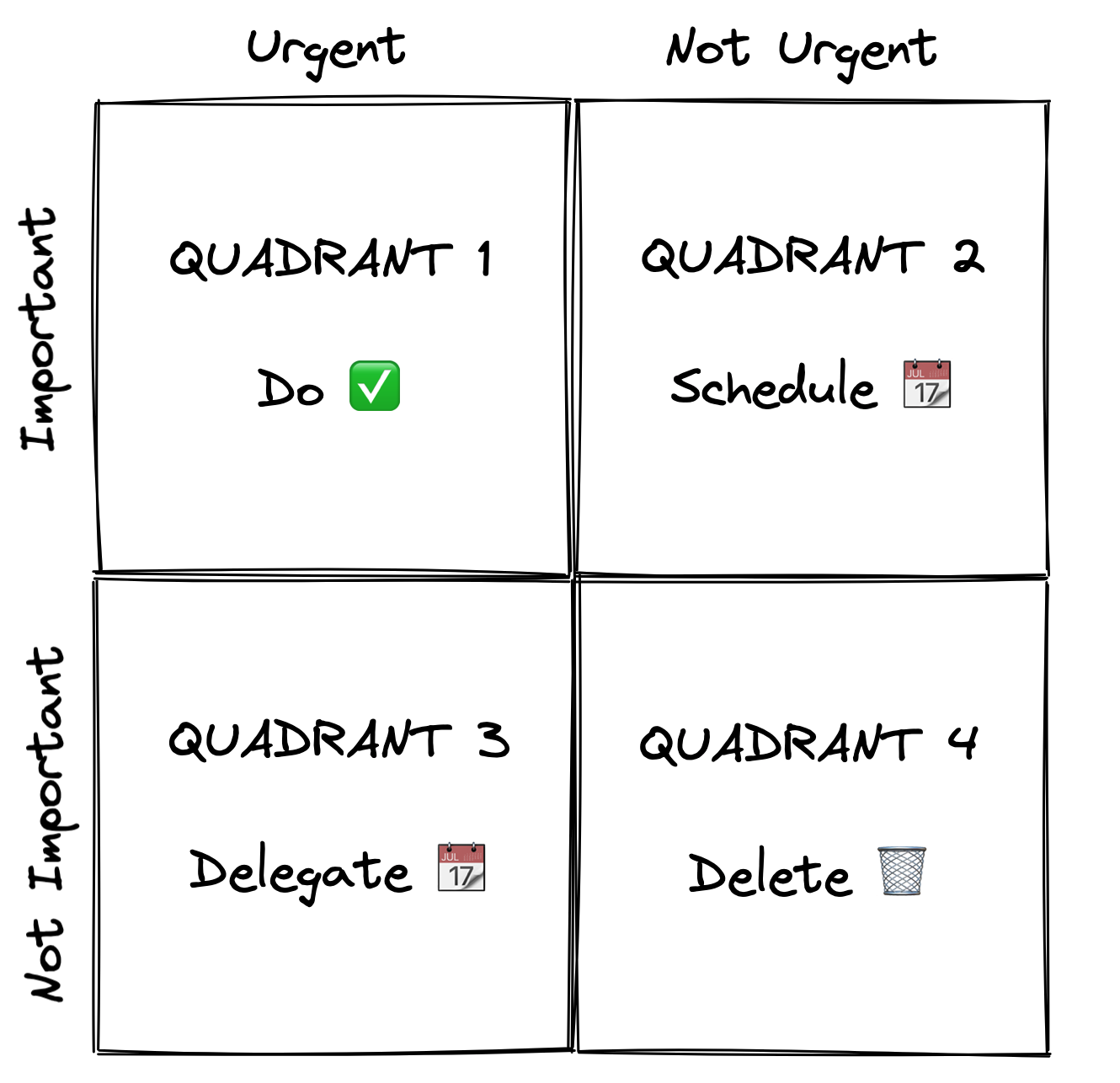Blog -




The Eisenhower Matrix: A Time Management Framework for Software Engineers
“The things that are urgent are seldom important, and the things that are important are seldom urgent.” — Dwight D. Eisenhower, probably
The quote above has inspired a well-established 2×2 matrix that provides a framework for thinking about how we spend our time.

On the x-axis is importance, which is anything that contributes to achieving our goals.
On the y-axis is urgency, which is anything that calls for our immediate attention.
Let’s walk through each quadrant to see where we tend to spend our time, and where we can get some time back!
Quadrant 1: Fire-fighting

In Quadrant 1, we find things that contribute to our personal, team and company goals AND have an immediate or fast-approaching deadline.
By default, this is the quadrant where the majority of time is spent. You might feel like you’re running from one fire to the next.
In a less chaotic way, sprint work is often filled with Quadrant 1 work. We choose the highest priority items from a backlog and commit to complete them in a certain timeframe.
I’m sure you can easily rattle off other urgent-import things that fill this quadrant.
There’s no question that you should do things that show up in this quadrant. They’re important. They’re due soon. The problem is that if you only work on urgent things, you’ll continually find yourself with an increasing amount of urgent things to do. This leaves little room or energy for improvement, innovation and accomplishing your long-term goals.
Quadrant 3: tsst duk-duk-duk

In Quadrant 3, we find even more urgent things The difference is that these urgent things aren’t important. Said another way, doing these particular urgent things won’t actually help us achieve our goals.
A familiar example for Quadrant 3 is a Slack notification. Notifications are one of the most common Quadrant 3 items. Most notifications don’t end being that important, but we’re conditioned to treat them as urgent.
If you find that you have a Pavlovian response to the default Slack notification sound, you’re not alone.
Quadrant 3 can be a bit of a trap in this way. We spend time addressing urgent things that feel important. But as Eisenhower may have said, that’s seldom the case.
The good news is that we can delegate these tasks in various ways to get some time back to work on things that are important to us.
Here are a few ideas:
- Schedule focus time where you can set your notifications to Do Not Disturb. Delegate addressing your notifications to pre-determined blocks of time during the day. Pick times during the day when you’re already interrupted to address your notifications in a batch.
- At FloQast, it’s common for a pod to have a rotating Shield Duty. Individual engineers on a pod are assigned certain days to address incoming messages for their pod. This delegates the interruptions to one person while protecting the time and focus of others.
- If there’s something that’s not critical for you to do personally, ask yourself who else could benefit from doing it, or being trained on it. Use these as tools in your mentoring toolbox.
- Some recurring work can be delegated to a script. Looks for ways to automate it.
- Practice saying “no”, or “not right now”. For me, it often feels wrong to say no, but think of it this way: saying yes to spending time on something not important, is effectively saying no to spending time on something that is important. Say no because of a bigger yes.
Here’s a simple script you could use: “I would love to do that, but I’m currently focused on completing A, B and C.”
Understanding this quadrant is key to the framework. Don’t confuse urgent things for being important. Don’t let them fill up your time. Instead, find ways to delegate.
Quadrant 4: The waiting place ⏳

If you find yourself killing time in Quadrant 4, it could be a sign that you have too much urgency in your work week. It becomes hard to start anything that’s not urgent because you know something urgent is lurking around the corner.
Reclaiming this time to do Quadrant 2 activities can make all the difference to pull you out of the urgency trap.
Quadrant 2

So what’s so special about Quadrant 2?
The urgency of Q1 and Q3 causes us to be reactive. We’re not in control. We’re at the mercy of the most urgent thing. Working on non-urgent items requires us to be proactive. These items won’t come knocking at our door, and scheduling them prevents them from becoming urgent later.
Some common Q2 activities that may already be built into your work week are 1:1s, Backlog Refinement and Mental Health Days.
Without a scheduled 1:1, it’s very likely that urgent items would fill in the space. Important but non-urgent things like career conversations would simply not happen. So we schedule them, because we know that they’re important and we want them to happen. Effectively, we make them urgent for ourselves.
Without a separately scheduled Backlog Refinement, we would be urgently estimating the complexity of stories during a Sprint Planning. Instead, we agree that it’s important and schedule time to do it while it’s not urgent.
At FloQast, every month has a long weekend. If there’s not already a built-in holiday, we schedule a Mental Health Day for everyone to take off at once. Time off is important, and scheduling it makes sure it happens.
Another Quadrant 2 idea: consider holding a pre-mortem before something leads to a post-mortem.
Look for more opportunities like these to schedule important things. Consider your urgent-to-scheduled ratio.
Steven Covey said it this way:
“What one thing could you do that you aren’t doing now that if you did on a regular basis would make a tremendous positive difference…?”
Schedule time for those things and you will find that your time spent working on urgent things will decrease and the time spent working on important things will increase.
Work done in Quadrant 2 is a gift to your future self
Conclusion
I hope this framework can help you find time by scheduling important work and reducing urgent work
Back to Blog
